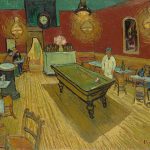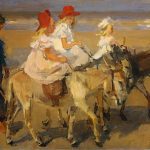
Jozef Israëls (1824-1911) was a Dutch painter known for his contributions to the Realist and Barbizon schools of art. He is considered one of the leading artists of the Hague School, a Dutch art movement that emerged in the 19th century. Israëls’ work often depicted scenes of rural life, peasants, and fishermen, and he is celebrated for his ability to capture the emotions and hardships of everyday people. Here are some key points about Jozef Israëls:

- Early Life and Training: Jozef Israëls was born on January 27, 1824, in Groningen, Netherlands. He initially studied painting at the Royal Academy of Fine Arts in Amsterdam under the guidance of Jan Adam Kruseman, a Dutch portrait painter.
- Barbizon and The Hague School: Israëls was heavily influenced by the Barbizon school of painting, which emphasized plein-air painting and a focus on capturing the natural world. He later became associated with The Hague School, which, like Barbizon, emphasized realism and a departure from the academic traditions.
- Subjects and Style: Israëls’ work often centered on the lives of peasants, fishermen, and rural communities. He was particularly skilled at portraying the daily struggles, joys, and sorrows of ordinary people. His paintings captured the effects of light and atmosphere, creating a sense of immediacy and emotional depth.
- Breakthrough Painting: One of Israëls’ most famous works is “The Rijksmuseum in Amsterdam” (1876). This painting marked a turning point in his career and is considered a masterpiece. It depicted a group of poor children in a museum, highlighting the contrast between their impoverished lives and the art on display.
- International Success: Jozef Israëls gained international recognition for his art and exhibited his works in major European cities, including Paris and London. His ability to convey the human condition and the spirit of his time made him a highly regarded artist.

- Later Life and Legacy: Israëls continued to paint and exhibit his works well into his later years. He passed away on August 12, 1911, in The Hague. His legacy endures through his influential role in the development of Realism and The Hague School, as well as his impactful and emotive portrayals of everyday life.
- Artistic Family: Jozef Israëls’ artistic talent extended to his family. His son, Isaac Lazarus Israëls, also became a notable painter known for his Impressionist and Post-Impressionist works.
Jozef Israëls’ dedication to depicting the lives of ordinary people, his commitment to Realism, and his ability to infuse his paintings with deep emotional resonance have left a lasting impact on the world of art. His works continue to be appreciated for their realism and the insight they provide into the human experience of the 19th century.




